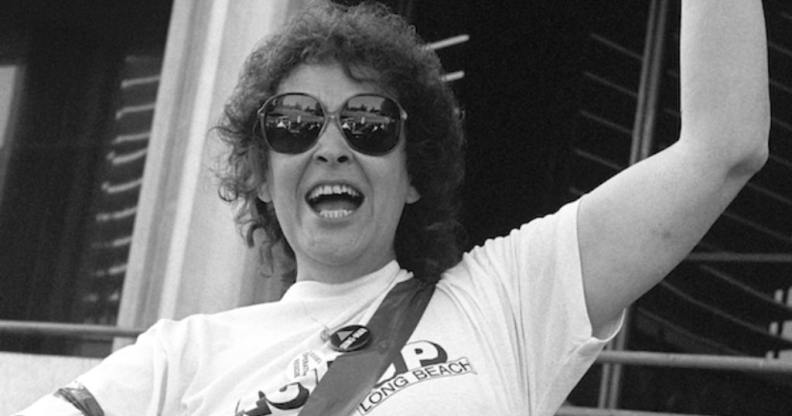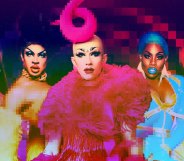Fearless trans ‘AIDS diva’ Connie Norman had been largely forgotten, but this new film shines a spotlight on her story

AIDS Diva: The Legend of Connie Norman tells the story of a trailblazing trans woman and AIDS activist who has been largely forgotten. (Provided)
In 1996, Connie Norman died after years of tirelessly fighting for the world to sit up and pay attention to AIDS.
In the years leading up to her death, Connie became a force to be reckoned with. Diagnosed with HIV in the 1980s, her sadness quickly turned to anger when she realised just how little the world cared about the virus that was spreading rapidly through queer communities. Through her involvement with ACT UP, Connie became one of Los Angeles’ most vocal AIDS activists – but today, she has been largely forgotten.
Almost 25 years since her death, Connie is being brought back to life with a new documentary. AIDS DIVA: The Legend of Connie Norman puts a spotlight on a trans AIDS activist who refused to be silenced during her short yet shimmering life.
“Connie came into my knowledge through one of my previous films,” director Dante Alencastre explains. “Somebody had gotten an award, it was called the Connie Norman Award for Excellence in the Movement. It was usually given to a trans woman.”
Connie’s name lingered in the back of Alencastre’s mind for a couple of years – and then, she came up in conversation in the most unusual way. While at a film screening, somebody sitting behind him tapped him on the back and asked him if he would consider making a film about Connie Norman.
“I did a little research, and somebody sent me the link of the interview Connie did with [conservative media commentator] Wally George. I was like, ‘Oh my God, who is this woman? Where has she been all my life?'”
Alencastre got in touch with ACT UP Los Angeles, and before long, a barrage of people who were friends with Connie came forward, eager to share their stories of the trailblazing icon. Remarkably, one of Connie’s friends came forward with a wealth of archival footage showing her life, her activism, and her profound wisdom and intellect. And just like that, Alencastre was making a film about Connie Norman.
‘AIDS Diva’ Connie Norman had to ‘speak louder’ to be heard
In interviews with friends and loved ones, Alencastre discovered the profound mix of love and respect Los Angeles’ queer community had for Connie. She was around a decade older than many of the activists leading the charge against AIDS, so many viewed her as a maternal figure, fighting not just for herself, but for the next generation.
However, Alencastre was surprised to find that some people saw her as “too much” – a characterisation he believes can easily be attributed to misogyny and patriarchal structures that positioned women as outsiders in AIDS activism.
“She was always speaking louder than everybody else. If she had been a cis man, they would have just said, ‘Oh, he’s rightfully angry.’ But because it was Connie Norman, they thought it was a little too much.
“I think there was an inherent – and I’m sorry, I hope the ACT UP people don’t hear this – but there was an inherent patriarchy in ACT UP because it was mostly men. Women had to speak louder, and Connie did. She had to speak louder and stand up and raise her voice, because otherwise they wouldn’t be heard because they were the minority in the group. At the time people thought that women didn’t get AIDS. For many years, until the late 80s, it was only a gay men’s issue.”
Connie pushed for federal and state governments to take action on the AIDS issue when many other queer people felt unable to do so. Alencastre was just 21-years-old when he first heard the term GRID, an early acronym for AIDS meaning gay-related immunodeficiency. He was living in New York at the time with his boyfriend, and he was “petrified”.
“I never went to a demonstration, even though I was down the street in Manhattan. I never went to a funeral, or memorial, or an ACT UP meeting. Nothing.”
There are a multitude of reasons why Alencastre did not get involved in AIDS activism at the time. The stigma attached to the virus was terrifying, and its prevalence in the community meant that even the common cold was a cause for concern. Looking back, Alencastre wishes he had been more vocal.
“I had a kind of survivor’s guilt, in a way, because I did not partake in anything. I was not very political back then. Nowadays, I am – I’ve gone through Black Lives Matter, and trans rights conferences and demonstrations and all that. But back then, I was just in my bubble with my boyfriend,” he says.
Making AIDS Diva has been a “redemptive” experience for Alencastre for precisely that reason. He wanted to shine a spotlight on the trailblazers who found the courage to speak out even when they knew they would be publicly lambasted for doing so. Alencastre was struck by Connie’s bravery in making his documentary – a quality he believes she developed through her difficult childhood and early adulthood.
She was a natural born leader. She really came from the ashes, and I think that’s something anybody can relate to.
AIDS activists were “enthralled” by Connie during her lifetime, Alencastre says – so why is it that she has been largely forgotten in the years since, while Larry Kramer and many others are remembered as heroes?
“I think in one word, it’s PTSD,” Alencastre says. “People didn’t want to look back. I mean, fortunately, Larry survived and was able to write about his experiences, and he just passed away last year. And then there were people who didn’t [survive], like Connie.”
Alencastre also believes it was left up to the trans community to remember Connie, while the rest of the queer community quietly moved on with their lives.
“I felt that Connie’s story and her legacy, it behooves all of us. Like she says in her last interview… she was queer, she was gender non-conforming, she was all of that. She was speaking for the gays and lesbians and everybody in our community which she adored, and which gave so much to her. And I think that her legacy lives on, and I want to be part of the rediscovery of her legacy that will continue in today’s youth.”
Making the documentary also came with a set of questions for Alencastre. He is keenly aware of debates surrounding who should tell certain stories. Some would argue that a story like Connie’s, about a trans woman, should be told by a trans director.
“There’s always been a fear to tread, like, ‘Oh you’re not trans so maybe you shouldn’t be digging into this history.’ And I’m very aware of it. I’m a cis, gay, queer filmmaker, but I have been intentional. I came to LA 14 years ago with a film which dealt with the trans activists in Peru, and that brought me to the knowledge of the community here. Some of the leaders came to see, ‘What is this guy doing? Is he showing surgeries, is he being sensational?’ And I was not. I was very respectful, very thoughtful.
“I can say right now, with pride, that some of my closest friends in this community, and my mentors, are trans women. And this is just my way to pay it back, to honour them and make them visible. And I hope I’m sensitive enough that I show them in the most truthful light that I can as a storyteller. I think as a storyteller we should be able to tell any stories that we want to, as long as we do it respectfully and with sensitivity, and with intentionality of empowering our community.”
Documentary breathes new life into Connie Norman’s story and activism
As the documentary is released to the world, Alencastre is hopeful that young queer people will see it and learn about the activists whose shoulders they stand on.
“This is not something that just began in the last 10 years, when they had Laverne Cox on Time magazine. It’s been going on for many, many, many centuries,” he says.
He continues: “I think the fact that we’re digging into the past to see where we came from gives her a really solid foundation and grounding for everything that’s going on right now. Here, (in America) we have 30 states that are trying to do anti-trans bills, from high schools to bathrooms… They’re always picking on the most vulnerable. I’ve done films about trans youth, so this really irks me that they’re picking on children.”
He notes that many of the families these laws will set out to harm are “vulnerable”, where parents often won’t know any queer people until their child comes out.
“You don’t want to have your first bully at home. You don’t want your dad to be your bully, you don’t want your mom to be your bully, or your older sister or older brother. So I think having these narratives of trans sisters like Connie, it’s so important for people to see that. They’re fearless, they’re warriors, they’re resilient, they’re disruptive. They could lead armies, like Connie did. She was the Clarion bell.”
Alencastre says he is “so blessed” that he had the opportunity to make a documentary about a powerful icon like Connie Norman.
“She was a natural born leader. She really came from the ashes, and I think that’s something anybody can relate to.”
AIDS Diva: The Legend of Connie Norman is streaming as part of London’s LGBT+ film festival, BFI Flare.





